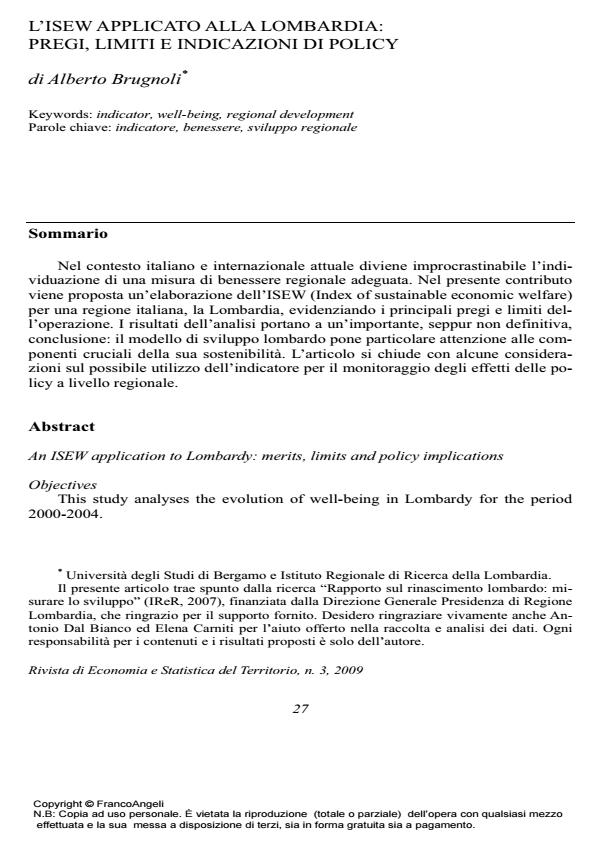L'ISEW applicato alla Lombardia: pregi, limiti e indicazioni di policy
Titolo Rivista RIVISTA DI ECONOMIA E STATISTICA DEL TERRITORIO
Autori/Curatori Brugnoli Brugnoli
Anno di pubblicazione 2009 Fascicolo 2009/3 Lingua Italiano
Numero pagine 26 P. 27-52 Dimensione file 362 KB
DOI 10.3280/REST2009-003002
Il DOI è il codice a barre della proprietà intellettuale: per saperne di più
clicca qui
Qui sotto puoi vedere in anteprima la prima pagina di questo articolo.
Se questo articolo ti interessa, lo puoi acquistare (e scaricare in formato pdf) seguendo le facili indicazioni per acquistare il download credit. Acquista Download Credits per scaricare questo Articolo in formato PDF

FrancoAngeli è membro della Publishers International Linking Association, Inc (PILA)associazione indipendente e non profit per facilitare (attraverso i servizi tecnologici implementati da CrossRef.org) l’accesso degli studiosi ai contenuti digitali nelle pubblicazioni professionali e scientifiche
An ISEW application to Lombardy: merits, limits and policy implications - This study analyses the evolution of well-being in Lombardy for the period 2000-2004. Methods and Results In order to measure well-being in Lombardy we used the ISEW (Index of Sustainable Economic Welfare) in the version produced by the New Economics Foundation. The ISEW is an index derived from a series of corrections and amendments to GDP, made with the aim of obtaining a comprehensive measurement which takes into account income distribution, environmental sustainability, and wealth stocks, and is immediately comparable with the indicator of regional income. Economic quantification of the components of the ISEW necessitated the use of discrete methodologies, in particular for determining the shadow prices of resources. The results also depend at least in part on these discretional elements. Over the period studied the ISEW for Lombardy was found to outperform per capita GDP, though this performance was not evenly distributed across all the components considered. Conclusions The analysis shows that economic growth achieved during 2000-2004 was not at the expense of sustainability; on the contrary, the development model looked carefully at the most crucial factors affecting sustainability itself. The study concludes by presenting some considerations on the possible use of this index for monitoring the impacts of regional policies.
JEL: I31, R11;
- Going regional: An index of sustainable economic welfare for Italy Chiara Gigliarano, Francesco Balducci, Mariateresa Ciommi, Francesco Chelli, in Computers, Environment and Urban Systems /2014 pp.63
DOI: 10.1016/j.compenvurbsys.2014.02.007 - The Index of Sustainable Economic Welfare: A Comparison of Two Italian Regions Francesco Maria Chelli, Mariateresa Ciommi, Chiara Gigliarano, in Procedia - Social and Behavioral Sciences /2013 pp.443
DOI: 10.1016/j.sbspro.2013.06.457
Brugnoli Brugnoli, L'ISEW applicato alla Lombardia: pregi, limiti e indicazioni di policy in "RIVISTA DI ECONOMIA E STATISTICA DEL TERRITORIO" 3/2009, pp 27-52, DOI: 10.3280/REST2009-003002